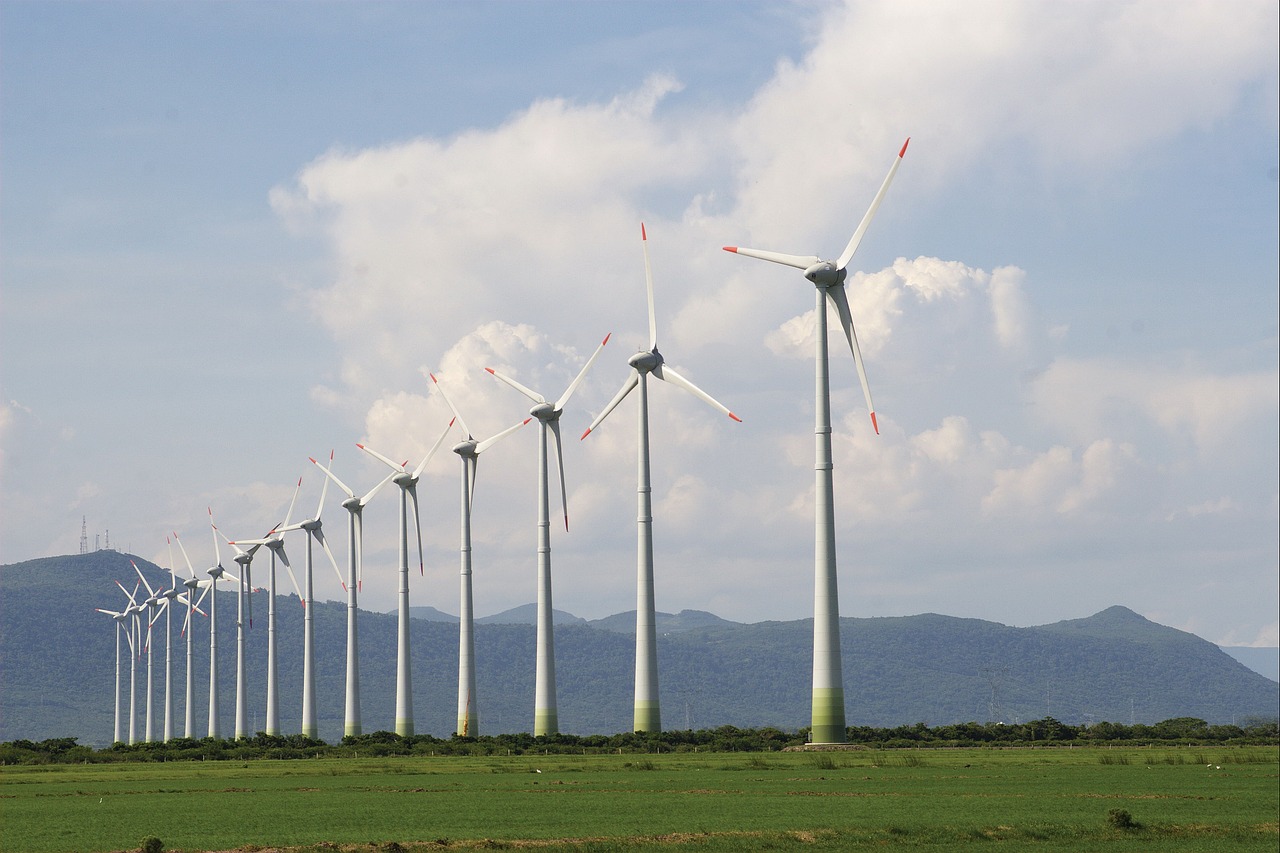The Role of Biomass Energy in Sustainable Living
In a world increasingly aware of the environmental challenges we face, the quest for sustainable living has never been more urgent. One promising avenue is biomass energy, a renewable resource derived from organic materials. But what exactly does this mean for our everyday lives? Imagine transforming waste into energy, reducing our carbon footprint, and contributing to a healthier planet—all through the power of biomass. This article delves into the multifaceted role of biomass energy, examining its benefits, challenges, and its potential to revolutionize our approach to energy consumption.
Biomass energy is not just a buzzword; it's a practical solution that can help us transition from fossil fuels to more sustainable energy sources. By harnessing the energy stored in organic materials, we can produce electricity, heat, and even fuels for transportation. Think of it as nature’s way of recycling—using what we already have to create something new and beneficial. This not only enhances energy security but also promotes a circular economy where waste is minimized, and resources are utilized efficiently.
The journey towards a sustainable future is paved with innovation, and biomass energy stands at the forefront. It offers a unique opportunity to mitigate the impacts of climate change while fostering economic growth and job creation. As we explore the intricacies of biomass energy, we’ll uncover how it contributes to a greener lifestyle and what it means for our planet's future.
Biomass energy refers to energy produced from organic materials, such as wood, agricultural crops, and waste. These materials can be converted into usable energy forms through various processes. But why is biomass so important? It serves as a renewable source of energy, meaning it can be replenished naturally and is not subject to the same depletion concerns as fossil fuels. Imagine a world where our energy sources are as abundant as the crops we grow!
There are different types of biomass, and they can be categorized into several groups:
- Wood and Agricultural Residues: These include logs, chips, and leftover materials from farming.
- Energy Crops: Specially grown crops like switchgrass and miscanthus are cultivated for energy production.
- Waste Biomass: This encompasses food waste, yard waste, and even municipal solid waste.
Each of these categories can be converted into energy through methods such as combustion, gasification, and anaerobic digestion. The versatility of biomass makes it an attractive option for a sustainable future.
The advantages of biomass energy are numerous and impactful. One of the most significant benefits is its potential to reduce greenhouse gas emissions. By utilizing organic materials, we can decrease our reliance on fossil fuels, which are notorious for their carbon emissions. In fact, studies show that biomass energy can lead to a 40% reduction in carbon emissions compared to traditional energy sources.
When it comes to environmental sustainability, biomass energy plays a crucial role. By converting organic waste into energy, we are not just generating power; we are also tackling the issue of waste management. This dual benefit is a game-changer in our fight against climate change. Additionally, biomass energy helps restore ecosystems by promoting sustainable land use practices, ensuring that we can continue to benefit from nature's resources.
Biomass is often touted as a carbon-neutral energy source. But what does this mean? The concept of carbon neutrality implies that the carbon dioxide released during the biomass energy production process is roughly equal to the amount absorbed by the plants during their growth. This balance creates a closed-loop system that can significantly mitigate the overall carbon footprint of energy consumption.
Utilizing biomass energy is a powerful way to address waste reduction. By converting organic materials into energy, we can minimize the amount of waste that ends up in landfills. This not only helps to reduce landfill overflow but also promotes a more sustainable waste management system. Imagine a scenario where our trash becomes treasure, fueling our homes and businesses instead of polluting our environment!
Despite its many benefits, biomass energy is not without its challenges. Resource competition can arise, especially when agricultural land is repurposed for energy crops, potentially impacting food production. Moreover, sustainability concerns regarding the sourcing of biomass materials must be addressed to ensure that the environmental benefits outweigh any negative impacts.
Various technologies are employed to convert biomass into energy, each with its own advantages and applications. Understanding these technologies is essential for maximizing the potential of biomass energy in our quest for sustainability.
Combustion is one of the most traditional methods of biomass energy production. It involves burning biomass to produce heat, which can then be converted into electricity. While effective, the efficiency of combustion techniques can vary, and advancements are being made to improve their performance and reduce emissions.
Innovation is key in the biomass energy sector, with emerging technologies continually enhancing efficiency and sustainability. From advanced gasification processes that convert biomass into clean gas to anaerobic digestion methods that produce biogas from organic waste, the future of biomass energy is bright. These advancements not only improve energy output but also align with environmental goals.
- What types of materials can be used for biomass energy? Biomass energy can be produced from wood, agricultural residues, energy crops, and organic waste.
- Is biomass energy truly carbon neutral? Yes, biomass energy is considered carbon neutral because the carbon dioxide released during energy production is balanced by the amount absorbed by plants during their growth.
- What are the main challenges facing biomass energy? Challenges include resource competition, sustainability concerns, and the need for technological advancements.

What is Biomass Energy?
Biomass energy is a fascinating and dynamic form of renewable energy derived from organic materials. It encompasses a wide array of sources, including plant matter, agricultural residues, and even animal waste. Essentially, any material that originates from living organisms can be converted into energy, making biomass a versatile player in the renewable energy landscape. This energy can be harnessed through various methods, turning everyday organic materials into power that can heat our homes, fuel our vehicles, and even generate electricity.
To understand biomass energy better, let's break it down into its primary types:
- Wood and Wood Residues: This includes logs, chips, bark, and sawdust, which are often used in heating and electricity generation.
- Agricultural Residues: Leftover materials from crops, like corn stalks and wheat straw, can be used to produce energy, enhancing the sustainability of farming practices.
- Energy Crops: These are specially grown plants, such as switchgrass or miscanthus, cultivated specifically for energy production.
- Animal Manure: Waste from livestock can be processed to generate biogas, a clean energy source.
The process of converting biomass into usable energy typically involves a few key steps. First, the organic material is collected and prepared, often requiring drying or grinding to optimize its energy content. Next, it undergoes conversion through various methods, which can include combustion, gasification, or fermentation, each tailored to the type of biomass and the desired end product. This versatility in conversion techniques not only maximizes efficiency but also allows for a wide range of applications, from direct heating to electricity generation.
One of the most exciting aspects of biomass energy is its potential to contribute to a sustainable energy future. By utilizing waste products and renewable materials, biomass energy can help reduce our reliance on fossil fuels, thereby decreasing greenhouse gas emissions and promoting a circular economy where waste is minimized. As we continue to explore and innovate in this field, biomass energy stands out as a promising solution for achieving a more sustainable and eco-friendly energy landscape.

Benefits of Biomass Energy
Biomass energy is often hailed as a shining beacon in the quest for sustainable living. Why, you ask? Well, it's not just about the energy it produces; it's about the myriad of benefits that come along with it. Imagine a world where waste is transformed into valuable energy, where greenhouse gas emissions are significantly reduced, and where renewable energy sources are not just a dream, but a reality. This is the promise of biomass energy!
One of the most compelling advantages of biomass energy is its ability to reduce greenhouse gas emissions. When we burn fossil fuels, we release a hefty amount of carbon dioxide into the atmosphere, contributing to climate change. In contrast, biomass energy can be considered a cleaner alternative. When biomass is burned, it releases carbon dioxide, but here's the kicker: the carbon dioxide emitted is roughly equivalent to the amount absorbed by the plants during their growth. This carbon neutrality is a game-changer in the fight against climate change.
Moreover, biomass energy plays a vital role in waste management. Think about it: every day, we generate tons of organic waste from our homes, farms, and industries. Instead of letting this waste pile up in landfills where it contributes to methane emissions, we can convert it into energy. This not only helps in managing waste but also reduces our reliance on landfills, which are notorious for polluting the environment. By utilizing biomass, we create a circular economy where waste is transformed into a resource, promoting a more sustainable future.
Let’s not forget about the economic benefits. The biomass energy sector creates jobs in rural areas, where many biomass resources are sourced. From farmers growing energy crops to technicians operating biomass plants, the potential for job creation is substantial. This can lead to economic growth in communities that might otherwise struggle. Plus, as we invest in biomass energy, we reduce our dependence on imported fossil fuels, which can stabilize local economies and energy prices.
In addition, biomass energy can enhance energy security. With a diverse array of biomass sources available—ranging from agricultural residues to dedicated energy crops—countries can tap into local resources instead of relying heavily on foreign oil. This not only diversifies the energy portfolio but also ensures a more stable energy supply for the future.
In summary, the benefits of biomass energy extend far beyond just energy production. It offers a pathway to environmental sustainability, effective waste management, job creation, and enhanced energy security. As we continue to explore and invest in this renewable energy source, we can pave the way for a greener, more sustainable future.
- What types of materials can be used for biomass energy? Biomass energy can be derived from a variety of organic materials, including agricultural residues, wood chips, and even municipal solid waste.
- Is biomass energy truly carbon neutral? While biomass is considered carbon neutral, it is essential to manage it sustainably to ensure that the carbon released does not exceed the carbon absorbed during the growth of the biomass.
- What are the main technologies used in biomass energy production? Common technologies include combustion, gasification, and anaerobic digestion, each with its own set of advantages and applications.

Environmental Impact
When it comes to the of biomass energy, the conversation is both exciting and essential. Biomass energy, derived from organic materials, plays a significant role in reducing our carbon footprint and promoting a cleaner, greener planet. Unlike fossil fuels, which release a plethora of greenhouse gases, biomass energy can be a game-changer in our fight against climate change. By using biomass, we can tap into a renewable energy source that not only generates power but also contributes to the sustainability of our environment.
One of the most compelling arguments for biomass energy is its potential to significantly lower carbon emissions. When biomass is burned for energy, the carbon dioxide released is roughly equivalent to the amount absorbed by the plants during their growth. This process creates a carbon-neutral cycle, where the net carbon emissions are drastically reduced. For instance, a study by the Environmental Protection Agency (EPA) indicates that biomass can reduce greenhouse gas emissions by up to 80% compared to traditional fossil fuels.
Moreover, the use of biomass energy contributes to effective waste management. In a world where landfills are overflowing, the ability to convert organic waste into energy is a breath of fresh air. By utilizing agricultural residues, wood chips, and even municipal solid waste, biomass energy facilities can transform what would otherwise be discarded into valuable energy. This not only helps in managing waste but also minimizes the environmental impact associated with waste disposal methods like landfilling and incineration.
To further illustrate the environmental benefits of biomass energy, let's take a look at some key points:
- Reduction of Greenhouse Gases: Biomass energy significantly reduces greenhouse gas emissions compared to fossil fuels.
- Waste Utilization: Converting organic waste into energy helps in waste management and reduces landfill use.
- Sustainable Resource: Biomass can be sourced sustainably, ensuring a continuous supply without depleting natural resources.
However, it's essential to approach biomass energy with a balanced perspective. While it offers numerous environmental benefits, we must also consider the sustainability of the resources used. For instance, if forests are over-harvested for biomass fuel, it could lead to deforestation and loss of biodiversity. Therefore, the key lies in sustainable practices and responsible sourcing of biomass materials, ensuring that we do not compromise the very ecosystems we aim to protect.
In conclusion, the environmental impact of biomass energy is a multifaceted topic that presents both opportunities and challenges. By harnessing this renewable energy source wisely, we can pave the way for a sustainable future, significantly reduce our carbon emissions, and promote effective waste management. The journey towards a greener planet is not just a dream; it's a reality we can create together through the responsible use of biomass energy.
- What is biomass energy? Biomass energy is derived from organic materials, such as plant and animal waste, which can be converted into usable energy.
- Is biomass energy renewable? Yes, biomass energy is considered renewable as it comes from organic materials that can be replenished naturally.
- How does biomass energy help reduce carbon emissions? Biomass energy is often carbon neutral, meaning the carbon dioxide released during energy production is balanced by the carbon dioxide absorbed during the growth of the biomass.
- What are the challenges associated with biomass energy? Some challenges include resource competition, sustainability concerns, and the potential for deforestation if not managed responsibly.

Carbon Neutrality
When we talk about , we're diving into a fascinating concept that can significantly impact our environment. Simply put, carbon neutrality means balancing the amount of carbon dioxide emitted into the atmosphere with an equivalent amount of carbon removed from it. This is crucial in our fight against climate change. Now, how does biomass energy fit into this picture? Well, biomass is often hailed as a carbon-neutral energy source because the carbon dioxide released during its combustion is roughly equal to the amount absorbed by the plants during their growth. This creates a closed-loop system that can potentially minimize our overall carbon footprint.
To illustrate this further, let’s break it down:
- Growth Phase: Plants absorb carbon dioxide from the atmosphere as they grow. This is a natural process that helps to reduce the amount of CO2 in the air.
- Energy Production: When these plants are used as biomass energy, they are burned or converted into energy, releasing the stored carbon back into the atmosphere.
- Balance Achieved: If managed sustainably, this cycle can achieve a balance, leading to a net-zero carbon emission scenario.
However, achieving true carbon neutrality with biomass energy isn't as straightforward as it sounds. It requires careful management of biomass sources, ensuring that we are not depleting forests or using land that could otherwise support biodiversity. Moreover, the sustainability of biomass energy hinges on the methods used to grow, harvest, and convert organic materials into energy. For instance, if fossil fuels are used in the cultivation and transportation of biomass, the carbon neutrality claim becomes questionable.
In essence, while biomass energy holds the promise of contributing to a carbon-neutral future, its effectiveness largely depends on the practices surrounding its use. We must ensure that biomass is sourced from sustainable practices, such as waste materials or dedicated energy crops, to genuinely claim its carbon neutrality. This concept not only emphasizes the importance of renewable energy sources but also highlights the need for a holistic approach to energy production that considers environmental impacts at every stage.
- What is carbon neutrality? Carbon neutrality refers to balancing the amount of carbon emitted with an equivalent amount removed from the atmosphere.
- How does biomass energy contribute to carbon neutrality? Biomass energy is considered carbon neutral because the CO2 released during its combustion is offset by the CO2 absorbed by plants during their growth.
- What are the challenges to achieving carbon neutrality with biomass? Challenges include sustainable sourcing of biomass, potential use of fossil fuels in production, and land use impacts.

Waste Reduction
One of the most compelling aspects of biomass energy is its ability to tackle the growing problem of waste management. In our modern world, we generate an astonishing amount of waste daily, and traditional disposal methods, such as landfilling and incineration, can create significant environmental challenges. Biomass energy offers a transformative solution by converting organic waste into a valuable energy source. Imagine turning what would typically be garbage into a resource that powers our homes and industries! This not only reduces the volume of waste piling up in landfills but also mitigates the harmful emissions associated with waste decomposition.
When we think about waste reduction, it's essential to recognize the types of materials that can be utilized for biomass energy. Common sources include:
- Agricultural residues (like corn stalks and wheat straw)
- Food waste from households and restaurants
- Wood waste from lumber production
- Animal manure
By converting these organic materials into energy, we not only minimize waste but also close the loop in our consumption cycles. For instance, food waste that would otherwise decompose in a landfill can be anaerobically digested to produce biogas, which can then be used for heating or electricity generation. This process is akin to giving a second life to our waste, transforming what is typically seen as a burden into a beneficial resource.
Moreover, the waste reduction benefits of biomass energy extend beyond just energy production. By reducing the amount of waste sent to landfills, we can also lessen the environmental impact associated with waste management. This includes decreased greenhouse gas emissions, reduced leachate production, and lower demand for landfills, which often disrupt local ecosystems. It’s a win-win situation for both the environment and society!
In summary, the role of biomass energy in waste reduction is not just about energy production; it's about creating sustainable systems that respect our planet. By embracing biomass energy, we can significantly reduce our waste footprint while simultaneously contributing to a greener, more sustainable future. So, the next time you think about waste, remember that it can be more than just trash—it can be a valuable resource in the quest for sustainable living.
- What types of waste can be used for biomass energy? Biomass energy can utilize agricultural residues, food waste, wood waste, and animal manure.
- Is biomass energy truly sustainable? Yes, when managed properly, biomass energy can be a sustainable option that reduces waste and carbon emissions.
- How does biomass energy help combat climate change? By converting organic waste into energy, biomass reduces landfill waste, which in turn decreases greenhouse gas emissions.
- Can biomass energy completely replace fossil fuels? While biomass can significantly contribute to energy needs, it is most effective as part of a diversified renewable energy strategy.

Challenges of Biomass Energy
While biomass energy presents a promising avenue for sustainable living, it is not without its challenges. One of the primary issues is resource competition. As we strive to transition to renewable energy sources, the demand for biomass can lead to competition with food production. This is particularly concerning in regions where arable land is limited. When farmers are faced with the choice of growing food versus energy crops, the implications for food security can be significant. Imagine a world where the very land that once fed us is now dedicated to fueling our energy needs. This delicate balance is one that we must navigate carefully.
Another challenge is the sustainability of biomass sources. Not all biomass is created equal. Some sources, like agricultural residues or waste materials, can be harvested sustainably, while others, such as dedicated energy crops, may require extensive land, water, and fertilizers—potentially leading to deforestation and habitat loss. The environmental impact of sourcing biomass must be weighed against its benefits. For instance, if forests are cleared to grow energy crops, the carbon emissions from deforestation could negate the carbon neutrality that biomass energy aims to achieve.
Moreover, the technological limitations associated with biomass energy conversion processes can pose challenges. While methods such as combustion, gasification, and anaerobic digestion are available, they each come with their own set of complications, including efficiency issues and emissions. For instance, combustion, while traditional, can release pollutants if not managed properly. The efficiency of these processes can vary widely, which means that not all biomass energy production is equally effective or environmentally friendly.
Finally, public perception and policy frameworks surrounding biomass energy also play a crucial role in its adoption. Many people are unaware of the benefits of biomass or harbor misconceptions about its environmental impact. Misinformation can hinder the growth of biomass energy initiatives. Additionally, inconsistent regulations and lack of incentives can stifle innovation and investment in this sector. To truly harness the potential of biomass energy, we need to foster a supportive environment that encourages research, development, and public engagement.
In conclusion, while biomass energy offers a wealth of opportunities for sustainable living, it faces significant hurdles that must be addressed. By recognizing these challenges and working collaboratively to overcome them, we can unlock the full potential of biomass as a clean and renewable energy source.

Biomass Energy Technologies
When it comes to harnessing the power of biomass, a variety of technologies are employed to convert organic materials into usable energy. These technologies not only maximize energy output but also ensure that the process remains environmentally friendly. The most common methods include combustion, gasification, and anaerobic digestion. Each of these methods has its own unique advantages and applications, making them suitable for different types of biomass and energy needs.
To start, let's explore the traditional method of combustion. This technique involves burning biomass materials directly to produce heat energy. Think of it as the classic way of using fire to generate energy, much like how our ancestors cooked food and kept warm. Today, combustion is often used in power plants to generate electricity. The efficiency of this method can vary based on the type of biomass used, the technology applied, and the design of the combustion system. For example, modern biomass power plants are designed to maximize efficiency and minimize emissions, making them a cleaner alternative to fossil fuel power generation.
Next up is gasification, a more advanced technology that converts biomass into a gas known as synthesis gas or syngas. This process involves heating biomass in a low-oxygen environment, which breaks down the organic material into gaseous compounds. The syngas produced can then be used to generate electricity or can be further processed into fuels like methanol or hydrogen. This method is particularly exciting because it allows for a more versatile use of biomass, enabling the production of various energy forms from the same raw material.
Another innovative approach is anaerobic digestion, a process that breaks down organic matter in the absence of oxygen. This method is commonly used for managing waste, especially in agricultural settings. During anaerobic digestion, microorganisms decompose the biomass, producing biogas, which is primarily composed of methane. This biogas can be used for heating, electricity generation, or even as a vehicle fuel. The beauty of this technology lies in its ability to reduce waste while simultaneously producing renewable energy. It's like turning trash into treasure, effectively addressing both energy and waste management challenges.
| Technology | Description | Applications |
|---|---|---|
| Combustion | Burning biomass to produce heat and electricity. | Power plants, heating systems. |
| Gasification | Converting biomass into syngas through partial combustion. | Electricity generation, fuel production. |
| Anaerobic Digestion | Breaking down organic matter without oxygen to produce biogas. | Waste management, renewable energy production. |
As we look to the future, emerging technologies in biomass energy are continually evolving. Innovations such as advanced fermentation processes and the development of specialized biomass crops are enhancing the efficiency and sustainability of biomass energy production. These advancements not only improve energy yields but also reduce the environmental impact associated with biomass cultivation and processing. It's an exciting time in the world of renewable energy, as we strive to find smarter, more efficient ways to utilize our natural resources.
- What is biomass energy? Biomass energy is derived from organic materials like plants and waste, converted into usable energy forms.
- How does combustion differ from gasification? Combustion burns biomass directly for heat, while gasification converts biomass into a gas for further energy production.
- Can biomass energy help with waste management? Yes, biomass energy technologies like anaerobic digestion can reduce waste while generating renewable energy.

Combustion Techniques
Combustion techniques represent one of the most traditional and widely used methods for converting biomass into usable energy. At its core, combustion involves burning organic materials to release heat, which can then be used to generate electricity or provide direct heating. This process is akin to lighting a campfire; the flames consume the wood, producing warmth and light, but in the case of biomass, the process is harnessed for energy production on a much larger scale.
There are several combustion techniques employed in biomass energy production, each with its own unique characteristics and efficiencies. The most common methods include:
- Direct Combustion: This is the simplest form of biomass energy conversion, where biomass is burned directly to produce heat. It's often used in residential heating systems and industrial boilers.
- Co-firing: This technique involves burning biomass alongside fossil fuels in existing power plants. It helps reduce greenhouse gas emissions while utilizing current infrastructure.
- Fluidized Bed Combustion: In this method, biomass is suspended in a bed of hot sand or ash, allowing for more efficient burning and better heat transfer. This technique is particularly effective for larger biomass particles.
- Gasification: Though technically a step beyond combustion, gasification involves heating biomass in a low-oxygen environment to produce syngas, which can be burned for energy. This method is gaining traction due to its efficiency and lower emissions.
While combustion is an effective way to produce energy from biomass, it is not without its challenges. One of the primary concerns is the emissions produced during the combustion process. Although biomass is often touted as a cleaner alternative to fossil fuels, burning it can still release pollutants, including particulate matter and volatile organic compounds. To mitigate these issues, modern combustion systems are increasingly equipped with advanced filtration and scrubbing technologies that help capture these emissions before they enter the atmosphere.
Moreover, the efficiency of biomass combustion can vary significantly based on the type of biomass being used. For instance, hardwoods generally produce more energy compared to softwoods due to their denser composition. Understanding the energy content of different biomass materials is crucial for optimizing combustion processes and maximizing energy output.
In conclusion, while combustion techniques are a cornerstone of biomass energy production, ongoing research and technological advancements are essential to improve their efficiency and reduce environmental impacts. As we strive for a more sustainable future, embracing these traditional methods while innovating for better practices can help us harness the full potential of biomass energy.
1. What is biomass energy?
Biomass energy is produced from organic materials, such as plants and animal waste, which can be converted into usable energy forms through various processes, including combustion.
2. Is biomass energy renewable?
Yes, biomass energy is considered renewable because it is derived from organic materials that can be replenished over time, unlike fossil fuels which are finite.
3. What are the environmental benefits of biomass energy?
Biomass energy can help reduce greenhouse gas emissions, promote waste management solutions, and contribute to carbon neutrality when managed sustainably.
4. What are the challenges associated with biomass energy?
Challenges include competition for resources, sustainability concerns, and emissions produced during combustion. Addressing these issues is crucial for the future viability of biomass energy.

Emerging Technologies
In the ever-evolving landscape of renewable energy, in biomass energy are paving the way for a more sustainable future. As we strive to reduce our carbon footprint and combat climate change, these innovations are crucial. One of the most exciting developments is the advancement in pyrolysis, a process that thermally decomposes organic material in the absence of oxygen. This method produces bio-oil, biochar, and syngas, all of which can be utilized as energy sources. The versatility of pyrolysis not only enhances energy production but also contributes to soil health when biochar is used as a soil amendment.
Another noteworthy technology is anaerobic digestion, which breaks down organic matter such as food waste and manure in a controlled environment. This process produces biogas, primarily composed of methane, which can be used for heating or electricity generation. The beauty of anaerobic digestion lies in its ability to tackle waste management issues while simultaneously generating energy. Imagine turning your kitchen scraps into power for your home! This circular approach not only reduces landfill waste but also provides a renewable energy source.
Moreover, the integration of microbial fuel cells is revolutionizing how we think about energy generation from biomass. These cells use bacteria to convert organic matter directly into electricity. They are still in the experimental stages but show great promise for future applications. By harnessing the natural processes of microorganisms, we can create a clean energy source that minimizes environmental impact.
As we dive deeper into these technologies, it's essential to consider their scalability and efficiency. For instance, the efficiency of biomass conversion technologies can vary significantly based on the feedstock used and the specific process employed. Below is a table that summarizes the efficiency rates of various biomass conversion technologies:
| Technology | Conversion Efficiency (%) | Typical Feedstocks |
|---|---|---|
| Combustion | 20-25 | Wood chips, agricultural residues |
| Gasification | 60-70 | Wood, biomass pellets |
| Anaerobic Digestion | 50-70 | Food waste, manure |
| Pyrolysis | 50-80 | Wood, agricultural waste |
These advancements are not just about improving efficiency; they also focus on sustainability. For example, researchers are working on genetically modifying microorganisms to enhance their ability to break down organic materials more effectively, thereby increasing biogas yields. This kind of innovation highlights the potential for biomass energy to integrate with other renewable technologies, creating a synergistic approach to energy production.
As we look to the future, the potential of biomass energy technologies is vast. With continued research and investment, we can expect to see even more groundbreaking solutions that will not only help us meet our energy needs but also protect our planet for generations to come. The journey towards a sustainable future is just beginning, and biomass energy is at the forefront of this exciting evolution.
- What is biomass energy? Biomass energy is energy produced from organic materials like plants and waste.
- How is biomass energy converted into usable energy? Biomass can be converted through methods such as combustion, gasification, and anaerobic digestion.
- Is biomass energy renewable? Yes, biomass energy is considered renewable as it utilizes organic materials that can be replenished over time.
- What are the environmental benefits of biomass energy? Biomass energy can reduce greenhouse gas emissions, manage waste, and promote carbon neutrality.
- What challenges does biomass energy face? Challenges include resource competition, sustainability concerns, and the need for technological advancements.
Frequently Asked Questions
- What is biomass energy?
Biomass energy is derived from organic materials like plants, agricultural residues, and even animal waste. It's a renewable energy source that can be converted into electricity, heat, or biofuels. Think of it as nature's way of recycling, turning waste into something valuable!
- How does biomass energy contribute to sustainable living?
Biomass energy plays a crucial role in sustainable living by reducing reliance on fossil fuels, lowering greenhouse gas emissions, and promoting waste management solutions. By utilizing organic waste, we can create energy while minimizing our carbon footprint. It’s like getting a second chance for our trash!
- Is biomass energy carbon neutral?
Yes, biomass energy is often considered carbon neutral because the carbon dioxide released during energy production is roughly equal to the amount absorbed by the plants during their growth. This balance helps mitigate climate change, making it a cleaner energy option compared to fossil fuels.
- What are the main challenges of biomass energy?
While biomass energy has many benefits, it also faces challenges such as competition for land and resources, sustainability concerns, and the need for efficient technologies. Addressing these issues is essential for maximizing the potential of biomass as a renewable energy source.
- What technologies are used to convert biomass into energy?
There are several technologies for converting biomass into energy, including combustion, gasification, and anaerobic digestion. Each method has its unique processes and efficiencies, allowing us to harness biomass in various ways to meet our energy needs.
- What is combustion in biomass energy production?
Combustion is one of the oldest and most common methods for producing biomass energy. It involves burning biomass to generate heat, which can be used to produce steam for electricity generation. While effective, it’s important to manage emissions to ensure environmental sustainability.
- Are there any emerging technologies in biomass energy?
Absolutely! Innovations in biomass energy technologies are constantly evolving. Recent advancements focus on improving efficiency and sustainability, such as enhanced gasification methods and more effective anaerobic digestion processes. These innovations help us make better use of biomass resources.



















